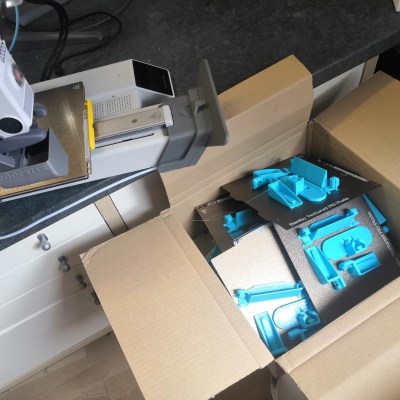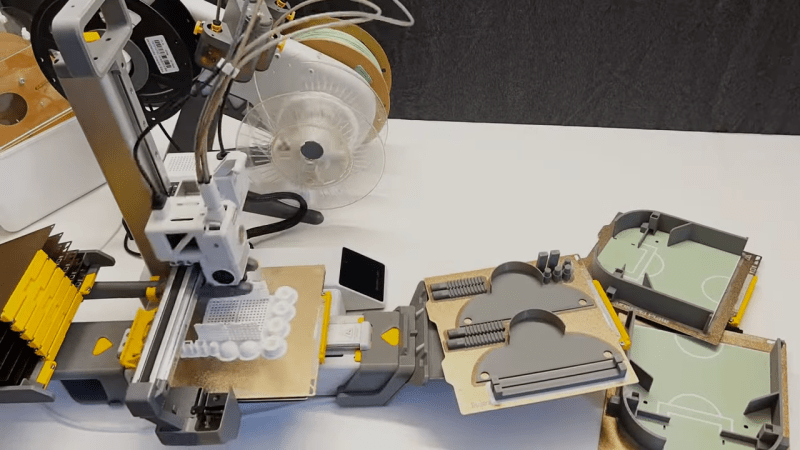[Andre Me] has long-standing interest in automating 3D print jobs, and his latest project is automating build plate changes on the Bambu A1 Mini.
 Here’s how it works: each build plate gets a sort of “shoe” affixed to it, with which attachments on the printer itself physically interact when loading new plates and removing filled ones.
Here’s how it works: each build plate gets a sort of “shoe” affixed to it, with which attachments on the printer itself physically interact when loading new plates and removing filled ones.
When a print job is finished, custom G-code causes an attachment on the printer to wedge itself under the build plate and peel it off until it is freed from the magnetic bed, after which the finished plate can be pushed towards the front. A stack of fresh build plates is behind the printer, and the printer slips a new one from the bottom when needed. Again, since the printer’s bed is magnetic, all one has to do is get the new plate to reliably line up and the magnetic attraction does the rest.
Some methods of automating print jobs rely on ejecting the finished parts and others swap the print beds. [Andre]’s is the latter type and we do really like how few moving parts are involved, although the resulting system has the drawback of requiring considerably more table space than just the printer itself. Still, it’s not at all a bad trade-off.
Watch it in action in the two videos embedded below. The first shows a time-lapse of loading and ejecting over 100 build plates in a row, and the second shows the whole system in action printing bowls in different colors.
















I was skeptical until I saw just how dead simple the concept is with the bed slinger. Cool! My gut tells me this wouldn’t be that great for print farms (mostly because it’s so easy to make a coreXY go real fast), but if you have one small printer it could take a week-long print project, tending the machine twice a day, to a two-day project.
the idea sounds great but I’m not sure I’d be keen on letting $20 build plates crash into each other when they’re being ejected into a box, it seems like there’s a high likelihood of getting damaged plates and/or damaged parts.
That’s just this demo … A production line would put some continuity device at the end like a roller tray or conveyor belt leading to some next automation or a waiting zone for intermittent human interaction once or twice a day or so
That’s a cool idea, though it seems most practical for people that run lots of print jobs on their printer, such as those running a print farm.
I mean, yeah, that’s the point. You wouldn’t want this if you aren’t keeping your printer busy 24/7.
a “shoe”, really?
Shoe mounting systems are common in photography, videography, and audio recording.
Yes really.
This has me curious on exactly how its working, as if it is as it looks a purely passive mechanism does this mean the printer actually has more travel than it can use in the bed slinging axis? Or is this giving up some build volume so the release peel catch thing and new bed grabber can’t trigger in normal print operations?
I’ve done a skim through the available resources and it didn’t jump out at me (not worth a deeper dive for me as I don’t own and probably never will own that printer).
For me it was the other way around. The weird camera angles that don’t show much just raised my annoyance level enough to quit bothering.
You can see a cable leading to the add-on for the front of the printer. That drives a motor that tilts the lifter bar up. The shoe has a slot that fits a triangular bit on top of the lifter. At the end of the print, the printer moves the bed to max Y which engages the shoe into the lifter. Something (not sure how it’s done with Bambulab hardware) runs the motor to tilt the bed off the carriage.
The lifter uses friction to keep the shoe in place when it’s tilted up, so sliding the bed back while it’s engaged and lifted causes it to scoot forward on the bed. Then it drops down, letting the shoe slide free. The old bed is partially on the magnetic carriage and mostly hanging off the front at this point, and moving it forward all the way catches it on the ramp at the front. A wiggle back and forth completely dislodges it and tips it over the ramp.
The hopper works with a catch at the back of the carriage that pulls on the next new bed when run all the way back. Once the new bed is partially pulled out, the carriage moves back until the shoe drops over the front edge and aligns it to the carriage for the next print.
It’s an elegant solution to continuous printing as long as you have enough beds to keep it busy while unattended. The only missing part is a sensor to tell when the hopper is empty.
Perhaps Donald should mention the patent infringement case by Stratasys.
Care to elaborate?
Can this be adapted to any other 3d printers??
It looks like the makerbot patents are expiring in a mere….6 years.
Honestly, it feels a lot closer than it did in 2014.
I really dont like it. The 3D Printing community is all about tinkering, sharing knowledge and improving things together. By selling these and not making anything of that open source (which would not hurt sales for sure) show that its not about the community instead its only profit what is in general okay (I think) but for me personally not support worthy.
I would also be a proponent to having an open source version of this that people can print and build themselves and adapt to their own printers. If anyone knows of such a project I would really like to contribute..